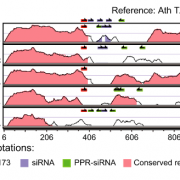Plant Journal: Rapid divergence of miRNAs and miRNA targets
Rapid divergence and high diversity of miRNAs and miRNA targets in the Camelineae.
Smith LM, Burbano HA, Wang X, Fitz J, Wang G, Ural-Blimke Y, Weigel D.
MicroRNAs (miRNAs) are short RNAs involved in gene regulation through translational inhibition and transcript cleavage. After processing from imperfect fold-back structures, miRNAs are incorporated into RNA-induced silencing complexes (RISCs) before targeting transcripts with varying degrees of complementarity. Some miRNAs are evolutionarily deep-rooted, and sequence complementarity with their targets is maintained through purifying selection. Both Arabidopsis and Capsella belong to the tribe Camelineae in the Brassicaceae, with Capsella rubella serving as an outgroup to the genus Arabidopsis. The genome sequence of C. rubella has recently been released, which allows characterization of its miRNA complement in comparison with Arabidopsis thaliana and Arabidopsis lyrata. Through next-generation sequencing, we identify high-confidence miRNA candidates specific to the C. rubella lineage. Only a few lineage-specific miRNAs have been studied for evolutionary constraints, and there have been no systematic studies of miRNA target diversity within or divergence between closely related plant species. Therefore we contrast sequence variation in miRNAs and their targets within A. thaliana, and between A. thaliana, A. lyrata and C. rubella. We document a surprising amount of small-scale variation in miRNA-target pairs, where many miRNAs are predicted to have species-specific targets in addition to ones that are shared between species. Our results emphasize that the transitive nature of many miRNA-target pairs can be observed even on a relatively short evolutionary time-scale, with non-random occurrences of differences in miRNAs and their complements in the miRNA precursors, the miRNA* sequences.



